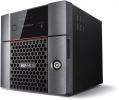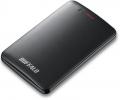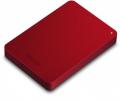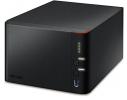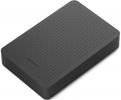Reviews related to : Buffalo
The need for storage capacity continues to grow. To help ease this situation, Buffalo has released a new TeraStation series.
Adding to its range of NAS (Network Attached Storage) devices, Buffalo has introduced its TeraStation™ 3010 series. This particular series consists of three main models covering capacities from 2TB up to 16TB with either 2 or 4 bays. I have been looking at the TS3210DN0202-EU model which is a 2-bay unit with a capacity of 2TB of storage. Featuring a pair of 1TB SATA drives, this NAS box is predominately black in colour although there are gun metal grey panels around the front of the unit.
Carrying your personal data in your pocket requires hardware such as the subject of this next review.
As data tends to become more mobile in its use, it is always useful to have a device or even multiple devices that can provide a combination of storage space, mobility and encryption protection. Recently Buffalo send me a device, falling into all these categories, to check out. This is the company’s MiniStation™ SSD-PMU3 product. The Buffalo MiniStation SSD is a portable hard drive.
Once a home has several computers the file or files you need will always be on another PC. Of course you can transfer most by USB stick or assuming they are connected by a Network by Wi-Fi or Ethernet, surely there is a better way.
Yes there is a NAS drive and before you stop reading saying they are complicated they need not be. Here is such an example from Buffalo, the Link Station 520. Another thing people are concerned about – size – this one is tiny for a two drive unit. The Buffalo Link Station 520 measures 20.5x8.5x13.5cm and weights 1.77kilos. Both sides and the top are blank. The front has a door to allow insertion or removal of drives.
Adding to its range of NAS boxes, Buffalo has released the LinkStation 520D. This is a two-bay unit that is available fully populated with a choice of 2, 4, 6 or 8TB of capacity and a choice of RAID settings. My review unit is the 2TB model.
Apart from the model label and a thin red strip over the top of the front cover, the LinkStation 520D NAS box is totally matte black in colour. Housed inside this black box (dimensions of 87 x 126 x 205mm) are two 3.5-inch SATA hard drives. By removing the front cover you can gain access to these drives if the need arises for either or both drives to be replaced for any reason. Power and function LEDs are positioned alongside the front cover.
In the past I have checked out various products designed to allow the streaming of media content to various smartphone and tablet devices. One feature that these products, from companies such as Kingston, Verbatim and PNY, had in common was that the user needed to provide the storage for the media being streamed. However this next media streaming product comes with its own storage. This is the Buffalo MiniStation Air or is it version 2?
Let me explain why there was some initial confusion regarding this particular product. While I had requested to review the new version of the product, entitled MiniStation Air 2, the package that arrived from Buffalo indicated that I had been sent the version of the product launched last year. Yet opening the box revealed a sheet of illustrated instructions referring to the MiniStation Air 2 and the unit’s appearance was that of the version 2 of the product.
Carrying a safe in your pocket might not seem possible but it can happen with a product from Buffalo.
While the capacity of flash sticks (sometimes referred to as thumb drives) has increased considerably since those early days of single figure MB. Or even smaller, modules, they have yet to approach even close to the capacity offered by portable hard drives. One example is the Buffalo MiniStation™ series of devices. Recently added to the company’s portfolio of hard disk devices is the Buffalo MiniStation Safe.
A number of such devices are now available this one from Buffalo offers 500GB (1TB also available) of storage. It can be used to automatically backup items from your phone should you wish, it uses its own Wi-Fi network.
The Buffalo MiniStation Air 2 measures 14.5x8.5x1.5cm and weights 250grams. The front edge has power input, USB3 port and connection button. The right side and back are clear while the left side has a USB2 port for charging of other devices. The front part of the top has a single on/off button and behind it four LEDs to denote various things.
While the Cloud is available to store data accessible in different locations, some still prefer having personal control provided by a portable hard drive.
Adding to its family of MiniStation™ products, Buffalo Technology, a global manufacturer of innovative storage, multimedia and wireless network products for the home and business users, has released its MiniStation Extreme model. This particular product is a portable storage hard drive that is available in either 1TB or 2TB capacities. My review unit is the 1TB version of the MiniStation Extreme.
Like my waist band, the amount of storage space I require continues to grow which encouraged me to check out a Buffalo NAS device.
Just how much disk storage space do you actually need? One possible answer, perhaps with more than a touch of tongue in cheek, might well be the retort of “the same again that I already have please”. Or to put in another way – we will never have enough storage space to satisfy the needs of our constantly growing amount of personal data.
As our personal store of data grows so does our need to access it from various locations. This next product offers a solution.
The Buffalo LinkStation 210 is a single drive network storage device. Offering a capacity of 2TB, the LinkStation 210 provides the user with the means to create their own personal cloud along with the ability to store, organise and back up data. Provided with the external drive unit, this kit contains a power lead with both two and three pin adaptors, flat style Ethernet lead, software disc and various items of documentation.
Do you want a fool proof way to access your photos, videos and music on a range of devices? While OTG is great it does not work on all devices. This uses Wi-Fi to do the work so once the data is on the unit it can be accessed.
The unit is chunky at 14.5x8.5x2cm and weights 250grams. Data can be attached or removed by USB and this device has both USB3 and USB2 ports. Charging of this solid battery powered unit is by a lead provided. One moan that when charging there is an LED that shows red from empty till fully charged when it shows green, it would be nice to know something in between. There are three other LEDs on the face on, Wi-Fi working and Wi-Fi linking.
While USB Flash Sticks continue to improve their functionality with regards to speed of reading and writing files, especially those products that now feature USB 3.0 technology, they still lag well behind the various pocket sized external drives with regards to the available capacity. Currently 64GB of capacity seems to be the ceiling for USB Flash Drive and, as a result they can not hope to compete on a level playing field with devices such as the Buffalo MiniStation offering which is the subject of this review.
The Buffalo MiniStation is available in a choice of white or black and comes in 500GB, 1TB or 2TB versions. My review is based on the 1TB version of this product. This USB 3.0 external drive has the appearance of like a slab of white chocolate but I would not recommend trying to eat it unless you want a few cracked teeth for your trouble. The top of the device is patterned in such a way that it reflects light in different patterns.
This has a rather special extra, it is a four port router it is a modem and it has a USB port and while a lot of other modem routers also have a USB port few (if any) can not only print but also scan and do other MFU tasks.
Assuming you stand the vertical the Buffalo AirStation HighPower ADSL Modem Router measures 17x18x3cm with leads plugged in but not including the two external aerials, these add another 9cm to the height. I am not going to say this was breeze to setup, as far as the modem and router side it was probably the easiest I have ever used.
As files get larger so the need for greater storage capacity increases with a corresponding improvement in data transfer.
As part of its new product line-up announcement at the Consumer Electronics Show inLas Vegas(unfortunately my invite and plane ticket somehow got lost in the post so I was unable to attend),Buffalointroduced the DriveStation Axis USB 3.0. This external desktop hard disk is available in either 1 or 2TB versions and comes with the promise of high speed access for the user. My review is based on the 1TB model which I have seen listed at £69.99.
If like me you can remember the early floppy disc long before hard discs then a MB was a great deal of space, early hard drives were a few MB, now we talk is hundreds of GB and so on till we arrive at the TB an even larger measure.
The DriveStation Duo is - as it rather gives away in the title – two drives in a single case. In my case they were two 1TB drives. You could purchase larger drives and it’s to you which sort of array you set them up into. The box is 21.5x12.5x8.5cm without the cables inserted in the rear and it weights a not insubstantial 1.91kilos. The front cover pulls off to reveal the two drives that just slide in and out of the drive bays.
A telephone call alerted me to the possibility of being one of the first to check out a new Blu-ray drive from Buffalo.
With more and more companies providing support for Blu-ray technology, it is perhaps time to consider adding a Blu-ray drive to your computer system. You could, of course, opt to just add a drive with read capability but why stop there when there is the greater storage capacity available with Blu-ray burning calling out to you. Maybe a drive with read/write features would be more appropriate. One solution could be the Buffalo Blu-ray product.
While there are many tiny (non powered) 500GB hard drives around this 1GB unit is not one of them, its large and needs its own power but has a range on interesting LEDs and a whole raft of software provided on a CD-ROM.
It is 18x17x4.5cm, the first figure the depth is when cables are plugged in. The unit weights 1135grams and it is shiny black in colour. Why do not manufacturers make such unit a non shiny colour so that fingermarks are not a problem? The front has a small square on/off button and when off it appears to have three small graphics to its right to show full, half full or empty. In fact when on there are a line of blue square LEDs that show the amount of free space on the drive.
What do you call a device that combines an external hard disk with an iPod docking station? To answer my own question the device is called Dualie.
So just what is a Dualie when it is at home? Developed by Buffalo Technology, the Dualie consists of a brushed aluminium and black docking station with two bays and an external hard disk. The front bay is used to mount your chosen iPod device while the rear bay is for the supplied 500GB external hard disk. Measuring 70 x 101 x 96mm (H x W x D), the docking station features the connections for attaching the iPod device and the external hard disk in the appropriate bays.
Although ratified towards the end of 2008, USB 3.0 devices are only just being to appear. An external hard drive is my introduction to the technology.
As sure as eggs are eggs, over the next coming months we are going to see various devices that come with support for the new USB 3.0 specifications. This technology has taken a little while to make the transition from ratification to device-enabled but the wait is over as products such as the Buffalo Ministation Lite USB 3.0 external disk drive make an appearance. This external drive is available in either 500GB or 640GB capacity.
Tired of waiting for data to be transferred using USB; then the wait could be over with the arrival of the latest 3.0 technology.
Unless you have been particularly quick off the mark, it is more than likely that your current system, no matter how powerful a speed hog it is, will not be capable of delivering the delights offered by SuperSpeed USB otherwise known as USB 3.0. This is the technology that promises to increase data rate transfers by as much as ten times over the previous version as well as offering simultaneously sending and receiving data through its duplex ability. While the USB 3.

